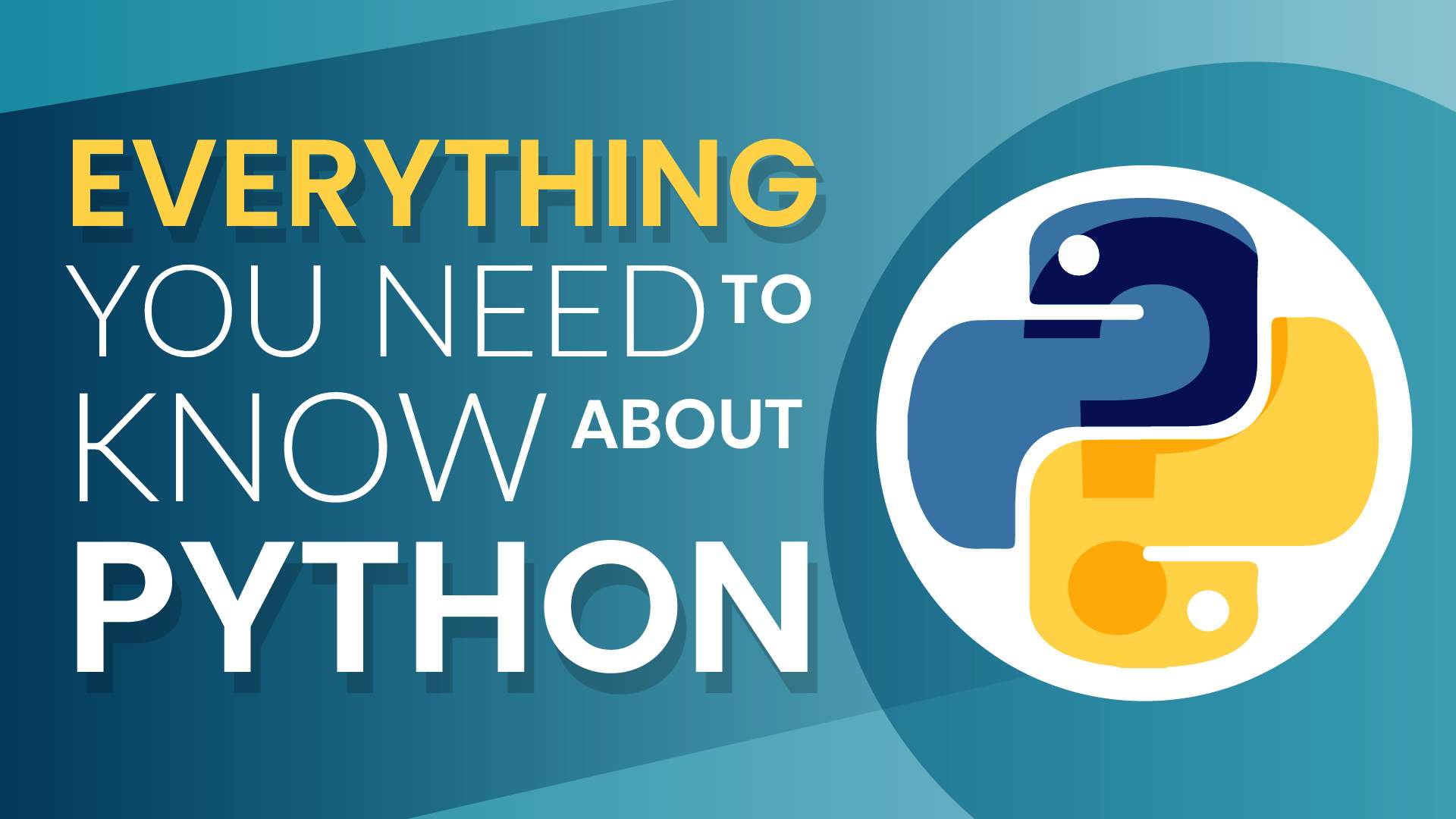04:48:56 pm 12/08/2023
Viewed: 6895
Everything You Need to Know About Python Programming
Introduction
Welcome to this Python tutorial where you will learn everything you need to know to start programming in Python. Whether you want to learn Python for data science, machine learning, or web development, this tutorial is the perfect place to start. You don't need any prior knowledge in Python or programming in general. I'm Mosh Hamadani, and I've taught millions of people how to code through this channel. If you're new here, make sure to subscribe as I upload new videos every week. Now let's jump in and get started!
What Can You Do with Python?
Before we get started, let me give you some ideas about what you can do with Python. Python is a multi-purpose programming language, so you can use it for a variety of different tasks. Here are a few examples:
Machine Learning and AI: Python is the number one language for machine learning and data science projects.
Web Development: Using Python and a framework called Django, you can build amazing websites. Some examples of websites powered by Python and Django are YouTube, Instagram, Spotify, Dropbox, and Pinterest.
Automation: With Python, you can save time and increase productivity by automating repetitive tasks.
Now I'm curious, why are you learning Python? Are you learning it for automation, data science, or web development? Let me know in the comment section below!
Getting Started with Python
The first thing I want you to do is to head over to python.org to download the latest version of Python. Go to the "Downloads" section and select the latest version. Once downloaded, double click the package to install it. If you're on Windows, make sure to check the "Add Python to Path" checkbox during the installation. This is important for following along with this tutorial. Once installed, open Python and let's get started.
Installing a Code Editor
Next, you need to install a code editor. We use a code editor to write and execute our Python code. The most popular code editor for Python is PyCharm. You can download it from jetbrains.com/pycharm. There are two editions available: the professional edition (commercial) and the community edition (free and open source). For this tutorial, we're going to download the community edition. Once downloaded, follow the installation instructions. Now you're ready to start coding!
Writing Your First Python Code
Let's create a new Python project in PyCharm. Specify the location and name of your project. In this window, you can see the content of our project. Right-click on the project name and go to "New" > "Python File". Let's call this file "app".
Now let's write our first Python code. We're going to write print("Hello, world!"). The print function is built into Python and we can use it to print a message on our application window. To run this code, go to the "Run" menu and select "Run". You should see the message "Hello, world!" printed in the terminal window.
Working with Variables
In Python, we use variables to store data in a computer's memory. For example, we can store the price of a product or someone's name, email, age, etc. To declare a variable, we start by typing a name for that variable, followed by an equal sign and the value we want to assign to it. For example, age = 20. With this, we're storing the number 20 somewhere in our computer's memory and attaching the label "age" to that memory location. We can then read the value at this memory location and print it on the terminal. For example, print(age).
Type Conversion
In Python, we have different types of data: numbers (integers and floats), strings, and booleans. There are times when we need to convert the value of a variable from one type to another. For example, if we have a variable birth_year stored as a string, we can convert it to an integer using the int() function. This allows us to perform calculations with it. Similarly, we can convert a number to a string using the str() function, or a value to a boolean using the bool() function.
Conditional Statements
In Python, we use if statements to make decisions in our programs. We can check if a certain condition is true and execute a block of code if it is. For example, we can check if a temperature is above a certain threshold and print a message accordingly. We can also use else and elif (short for else if) statements to handle multiple conditions. For example, we can check if a number is positive, negative, or zero and print a message accordingly.
Loops
Loops allow us to repeat a block of code multiple times. In Python, we have two types of loops: for loops and while loops. For loops are used when we know how many times we want to repeat the code, while loops are used when we want to repeat the code until a certain condition is met. For example, we can use a for loop to iterate over a list of numbers and perform some calculation for each number. We can also use a while loop to repeat a block of code until a certain condition is no longer true.
Working with Lists and Tuples
In Python, we have two types of sequences: lists and tuples. Lists are mutable, which means we can change them after creating them. Tuples, on the other hand, are immutable and cannot be changed once created. We use lists and tuples to store a sequence of objects, such as a list of numbers or a tuple of names. We can access individual elements in a list or tuple using their indexes, and we can perform various operations on them, such as adding or removing elements.
Using the range() Function
The range() function in Python allows us to generate a sequence of numbers. We can specify the start, end, and step values to customize the sequence. The range() function returns a range object, which can be used in a for loop to iterate over the sequence of numbers.
Conclusion
Congratulations! You have learned everything you need to know to start programming in Python. We covered a wide range of topics, including variables, conditional statements, loops, and working with lists and tuples. Python is a powerful programming language with a wide range of applications, from data science and machine learning to web development and automation. I hope you found this tutorial helpful and that it has inspired you to continue your journey in Python programming. If you have any questions or need further assistance, please feel free to leave a comment below. Happy coding!
Introduction
Welcome to this Python tutorial where you will learn everything you need to know to start programming in Python. Whether you want to learn Python for data science, machine learning, or web development, this tutorial is the perfect place to start. You don't need any prior knowledge in Python or programming in general. I'm Mosh Hamadani, and I've taught millions of people how to code through this channel. If you're new here, make sure to subscribe as I upload new videos every week. Now let's jump in and get started!
What Can You Do with Python?
Before we get started, let me give you some ideas about what you can do with Python. Python is a multi-purpose programming language, so you can use it for a variety of different tasks. Here are a few examples:
Machine Learning and AI: Python is the number one language for machine learning and data science projects.
Web Development: Using Python and a framework called Django, you can build amazing websites. Some examples of websites powered by Python and Django are YouTube, Instagram, Spotify, Dropbox, and Pinterest.
Automation: With Python, you can save time and increase productivity by automating repetitive tasks.
Now I'm curious, why are you learning Python? Are you learning it for automation, data science, or web development? Let me know in the comment section below!
Getting Started with Python
The first thing I want you to do is to head over to python.org to download the latest version of Python. Go to the "Downloads" section and select the latest version. Once downloaded, double click the package to install it. If you're on Windows, make sure to check the "Add Python to Path" checkbox during the installation. This is important for following along with this tutorial. Once installed, open Python and let's get started.
Installing a Code Editor
Next, you need to install a code editor. We use a code editor to write and execute our Python code. The most popular code editor for Python is PyCharm. You can download it from jetbrains.com/pycharm. There are two editions available: the professional edition (commercial) and the community edition (free and open source). For this tutorial, we're going to download the community edition. Once downloaded, follow the installation instructions. Now you're ready to start coding!
Writing Your First Python Code
Let's create a new Python project in PyCharm. Specify the location and name of your project. In this window, you can see the content of our project. Right-click on the project name and go to "New" > "Python File". Let's call this file "app".
Now let's write our first Python code. We're going to write print("Hello, world!"). The print function is built into Python and we can use it to print a message on our application window. To run this code, go to the "Run" menu and select "Run". You should see the message "Hello, world!" printed in the terminal window.
Working with Variables
In Python, we use variables to store data in a computer's memory. For example, we can store the price of a product or someone's name, email, age, etc. To declare a variable, we start by typing a name for that variable, followed by an equal sign and the value we want to assign to it. For example, age = 20. With this, we're storing the number 20 somewhere in our computer's memory and attaching the label "age" to that memory location. We can then read the value at this memory location and print it on the terminal. For example, print(age).
Type Conversion
In Python, we have different types of data: numbers (integers and floats), strings, and booleans. There are times when we need to convert the value of a variable from one type to another. For example, if we have a variable birth_year stored as a string, we can convert it to an integer using the int() function. This allows us to perform calculations with it. Similarly, we can convert a number to a string using the str() function, or a value to a boolean using the bool() function.
Conditional Statements
In Python, we use if statements to make decisions in our programs. We can check if a certain condition is true and execute a block of code if it is. For example, we can check if a temperature is above a certain threshold and print a message accordingly. We can also use else and elif (short for else if) statements to handle multiple conditions. For example, we can check if a number is positive, negative, or zero and print a message accordingly.
Loops
Loops allow us to repeat a block of code multiple times. In Python, we have two types of loops: for loops and while loops. For loops are used when we know how many times we want to repeat the code, while loops are used when we want to repeat the code until a certain condition is met. For example, we can use a for loop to iterate over a list of numbers and perform some calculation for each number. We can also use a while loop to repeat a block of code until a certain condition is no longer true.
Working with Lists and Tuples
In Python, we have two types of sequences: lists and tuples. Lists are mutable, which means we can change them after creating them. Tuples, on the other hand, are immutable and cannot be changed once created. We use lists and tuples to store a sequence of objects, such as a list of numbers or a tuple of names. We can access individual elements in a list or tuple using their indexes, and we can perform various operations on them, such as adding or removing elements.
Using the range() Function
The range() function in Python allows us to generate a sequence of numbers. We can specify the start, end, and step values to customize the sequence. The range() function returns a range object, which can be used in a for loop to iterate over the sequence of numbers.
Conclusion
Congratulations! You have learned everything you need to know to start programming in Python. We covered a wide range of topics, including variables, conditional statements, loops, and working with lists and tuples. Python is a powerful programming language with a wide range of applications, from data science and machine learning to web development and automation. I hope you found this tutorial helpful and that it has inspired you to continue your journey in Python programming. If you have any questions or need further assistance, please feel free to leave a comment below. Happy coding!
No video exists.





Comments